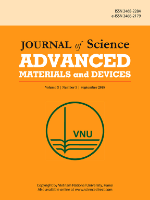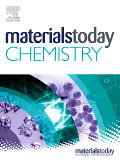
Journal of Science-Advanced Materials and Devices
Scope & Guideline
Innovating for Impact: Your Gateway to Advanced Materials
Introduction
Aims and Scopes
- Advanced Materials Synthesis:
The journal publishes research on the synthesis of new materials, including nanomaterials, composites, and polymers, emphasizing innovative techniques and methodologies. - Characterization Techniques:
Papers explore various characterization methods for advanced materials, including structural, optical, electrical, and mechanical properties, providing insights into material performance. - Applications in Electronics and Energy:
Research focuses on the application of materials in electronic devices, energy storage, and conversion technologies, such as solar cells, batteries, and sensors. - Biomedical Applications:
The journal covers studies on materials designed for biomedical applications, including drug delivery systems, tissue engineering, and diagnostic devices. - Environmental Applications:
There is a significant focus on materials and devices aimed at environmental sustainability, including wastewater treatment, pollution control, and renewable energy solutions. - Interdisciplinary Research:
The journal encourages interdisciplinary studies that combine materials science with physics, chemistry, engineering, and biology, fostering innovation in material applications.
Trending and Emerging
- Nanomaterials and Nanocomposites:
Research on nanomaterials, particularly their synthesis, characterization, and applications, is on the rise, highlighting their importance in various fields, including electronics, energy, and biomedicine. - Smart and Functional Materials:
There is an increasing focus on materials with smart properties, such as self-healing, stimuli-responsiveness, and multifunctionality, which are critical for next-generation applications. - Green and Sustainable Technologies:
Studies emphasizing eco-friendly synthesis methods and sustainable materials for energy and environmental applications are gaining traction, reflecting a global push towards sustainability. - Advanced Characterization Techniques:
Emerging methods for characterizing materials at the nanoscale, including advanced spectroscopic and imaging techniques, are increasingly represented, providing deeper insights into material properties. - Integration of AI and Machine Learning:
The incorporation of artificial intelligence and machine learning in materials research, particularly for predictive modeling and optimization of material properties, is becoming more prevalent. - Biomedical Engineering Applications:
There is a growing trend in research focused on the application of advanced materials in biomedical fields, including drug delivery, tissue engineering, and diagnostic devices, indicating a strong interdisciplinary approach.
Declining or Waning
- Conventional Materials:
There seems to be a decline in publications focused on conventional materials without innovative modifications or applications, as the field moves toward advanced and novel materials. - Basic Theoretical Studies:
Research that heavily emphasizes theoretical aspects without practical applications appears to be waning, as the journal increasingly favors studies with direct applications or experimental validation. - Traditional Manufacturing Techniques:
Papers discussing traditional manufacturing methods without integration of advanced technologies or materials seem to be less frequent, reflecting a shift towards innovative fabrication techniques. - Generalized Environmental Studies:
Research that broadly addresses environmental issues without specific material or technological solutions is becoming less common, as the journal prioritizes focused studies on advanced materials for environmental applications. - Non-functional Materials:
There is a noticeable decrease in studies centered on non-functional or passive materials, as the journal emphasizes the development and application of functional materials with specific properties.
Similar Journals

Materials Letters-X
Empowering Global Access to Cutting-Edge ResearchMaterials Letters-X, published by ELSEVIER, is an esteemed open-access journal dedicated to the rapid communication of research in the fields of Condensed Matter Physics, Materials Science, Mechanical Engineering, and Mechanics of Materials. Launched in 2019, this journal has quickly established itself within the academic community, achieving Q3 quartile rankings in several categories according to the 2023 metrics. The journal's impactful contributions are reflected in its Scopus rankings, notably within Mechanical Engineering (Rank #308) and Mechanics of Materials (Rank #199). The open-access model promotes widespread dissemination and accessibility, ensuring that cutting-edge advancements in material science are readily available to researchers, professionals, and students worldwide. As it continues to grow, Materials Letters-X aims to inspire innovation and collaboration across disciplines, making it a pivotal resource for those engaged in material research and applications.

Discover Nano
Unveiling the Potential of NanotechnologyDiscover Nano is a pioneering journal published by SPRINGER, dedicated to the rapidly evolving field of nanoscience and nanotechnology. Established in 2023, this innovative platform provides an open-access forum for researchers, professionals, and students to share and disseminate cutting-edge findings in materials science and condensed matter physics. With its commitment to accessibility, Discover Nano encourages a broad spectrum of contributions, aiming to foster collaboration and stimulate discussion in this dynamic area of study. As a new entry into the academic community, the journal holds great potential for growth, aspiring to increase its visibility and impact in the materials science arena, where it currently ranks in the bottom quartile for both materials science and physics categories. Based in Germany and reaching a global audience, Discover Nano represents a significant opportunity for those looking to shape the future of nanotechnology through impactful research and interdisciplinary dialogue.

JOURNAL OF SOL-GEL SCIENCE AND TECHNOLOGY
Bridging Theory and Application in Sol-Gel ScienceJOURNAL OF SOL-GEL SCIENCE AND TECHNOLOGY, published by Springer, is a vital resource within the interdisciplinary fields of materials science and engineering, focusing on innovative research related to sol-gel processes and applications. With a rich publication history spanning from 1993, this journal enables the dissemination of cutting-edge findings in biomaterials, ceramics, and composites, ranking impressively across various categories—Q3 in Biomaterials and Q2 in several other materials-related fields. The journal's commitment to quality research is reflected in its Scopus rankings, particularly notable in the categories of Condensed Matter Physics and Materials Chemistry. Researchers and professionals leveraging the insights from this journal are supported through its comprehensive scope, which bridges theoretical foundations with practical applications, advancing knowledge and fostering collaboration among academics and industry leaders alike. As a non-open access journal, it is essential for subscribers and institutions to engage deeply with the latest advancements documented within its pages, underscoring the journal's role in shaping the future of sol-gel science and technology.

Polymers
Exploring the forefront of materials innovation.Polymers is a premier journal published by MDPI, dedicated to advancing the field of polymer science and technology. This open-access journal, established in 2009, has quickly gained prominence in the academic community, serving as a vital platform for disseminating high-quality research articles, reviews, and communications in the realms of chemistry, polymers, and plastics. Based in Switzerland, with an impressive ranking in the Q1 quartile for both Chemistry and Polymer studies, Polymers boasts a significant impact factor, reflecting its rigorous peer-review process and esteemed editorial board. Researchers, professionals, and students alike benefit from the broad accessibility of content, allowing for a more extensive reach and engagement within the scientific community. As a key resource for the latest advancements and innovations in polymer research, Polymers continues to lead discussions, inspire collaborations, and foster the development of novel materials that shape various industrial applications.

Journal of Advanced Dielectrics
Transforming Knowledge into Practical ApplicationsThe Journal of Advanced Dielectrics, published by World Scientific Publishing Co Pte Ltd, is a pivotal open-access platform since 2014 dedicated to advancing research in the fields of dielectrics, ceramics, and composites. Based in Singapore, this journal aims to bridge the gap between theoretical developments and practical applications in Electrical and Electronic Engineering, Condensed Matter Physics, and Electronic, Optical, and Magnetic Materials. With an impressive classification in the 2023 Quartile Rankings indicating its significance within its categories, and notable Scopus Rankings that highlight its impact and relevance, this journal serves as a vital resource for scholars and professionals committed to cutting-edge research and innovation. As it continues to flourish through the converging years from 2015 to 2024, the Journal of Advanced Dielectrics stands as an essential conduit for the dissemination of knowledge in advanced material sciences, making it an indispensable asset for today's research community.

BULLETIN OF MATERIALS SCIENCE
Connecting Researchers to the Pulse of Materials ScienceBulletin of Materials Science, published by the Indian Academy of Sciences, is a distinguished journal that has been contributing to the field of materials science since its inception in 1979. With an ISSN of 0250-4707 and E-ISSN 0973-7669, it provides a platform for researchers to share groundbreaking studies and advancements in the mechanics of materials and general materials science. As of 2023, the journal holds a respectable Q3 ranking in both the Materials Science (miscellaneous) and Mechanics of Materials categories, highlighting its competitive position in the academic landscape. Although the journal currently does not operate under an open access model, it remains a vital resource for professionals and students keen on exploring innovative material developments and methodologies. With a commitment to promoting high-quality research, the Bulletin of Materials Science features rigorous peer-review processes, making it an essential reference for anyone engaged in the materials science domain.

Advanced Materials Interfaces
Transforming Engineering with Interfacial BreakthroughsAdvanced Materials Interfaces is a premier journal dedicated to the exploration and advancement of materials science, with particular emphasis on the interfacial phenomena that govern the behavior of materials in various engineering applications. Published by WILEY in the United Kingdom, this Open Access journal, established in 2014, has quickly ascended to a Q1 category ranking in both Mechanical Engineering and Mechanics of Materials as of 2023, reflecting its significant influence and excellence in the field. With impressive Scopus Ranks, such as #81 out of 672 in Mechanical Engineering and #58 out of 398 in Mechanics of Materials, it serves as a vital resource for researchers and practitioners aiming to push the boundaries of materials innovation. The journal provides unrestricted access to its cutting-edge research, promoting collaboration and dissemination of knowledge among the global scientific community, solidifying its role as a vital contributor to the ever-evolving landscape of materials engineering.

Nano Futures
Empowering Researchers with Open Access to Nano DiscoveriesNano Futures, published by IOP Publishing Ltd, is an influential journal dedicated to advancing the field of nanoscale science and technology, encompassing a wide range of disciplines such as Atomic and Molecular Physics, Bioengineering, and Materials Science. With a growing impact within the academic community, this journal has achieved a notable Q2 classification in categories like Chemistry and Electrical Engineering, making it a critical resource for researchers, professionals, and students seeking to explore innovative advancements in nanotechnology. Established in 2017 and operating through 2024, Nano Futures provides open access options for readers, ensuring wider dissemination and engagement with cutting-edge research findings. The journal's commitment to showcasing high-quality research makes it an essential channel for exploring the intersection of nanoscale innovations and practical applications in various industries.

MRS Communications
Exploring the frontiers of materials through peer-reviewed excellence.MRS Communications is a prominent academic journal published by Springer Heidelberg, focusing on the multidisciplinary field of materials science. With ISSN 2159-6859 and E-ISSN 2159-6867, this journal has been a valuable platform for disseminating cutting-edge research since its inception in 2011. Operating from its esteemed headquarters in Heidelberg, Germany, it aims to foster collaboration and innovation among researchers and practitioners by publishing high-quality, peer-reviewed articles. Holding a Q3 ranking in the Materials Science (Miscellaneous) category, and currently positioned at the 37th percentile in the general materials science field, MRS Communications is dedicated to advancing the understanding of materials through interdisciplinary studies. The journal offers researchers an opportunity to share insights that bridge theoretical knowledge with practical applications, contributing significantly to the global materials science community. As an essential resource for researchers, professionals, and students alike, we invite you to explore the latest advancements and discussions in materials science through this influential publication.

Materials Today Chemistry
Elevating Knowledge in Materials Science and ChemistryMaterials Today Chemistry, published by Elsevier Science Ltd, is a leading journal in the field of materials science, with a primary focus on innovative research and advancements in chemistry relating to materials. Operating under ISSN 2468-5194, the journal has made a significant impact in various specialized areas such as biomaterials, catalysis, colloid and surface chemistry, and polymers, achieving a Q1 ranking across these categories in 2023. With its commitment to high-quality, peer-reviewed content, Materials Today Chemistry serves as an essential platform for researchers, professionals, and students aiming to stay at the forefront of materials research. The journal provides an open access model, enabling wide dissemination of research findings and fostering collaboration among the scientific community. Its esteemed ranking on Scopus, including a remarkable percentile position in materials chemistry and catalysis, underscores its importance in advancing the understanding and application of novel materials. Whether you're delving into cutting-edge synthesis techniques or exploring the latest in materials applications, Materials Today Chemistry remains a pivotal resource for breakthrough discoveries and pivotal insights in the realm of materials science.